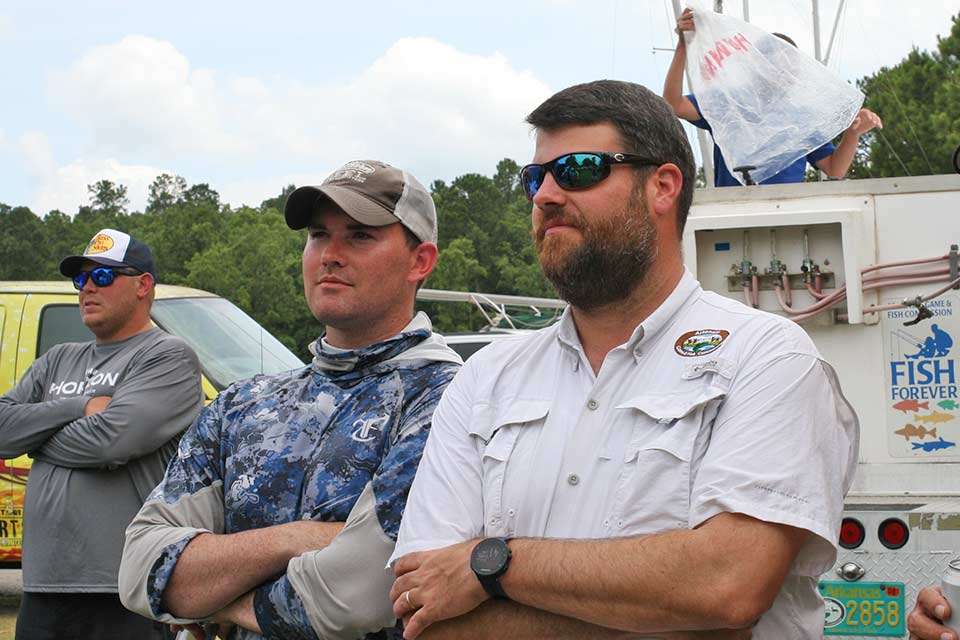
Fisheries biologist advises anglers to live and let fish
It’s great that many anglers care about the health of bass fisheries, yet Arkansas’ top fisheries biologist often wonders if things sometimes go too far.
Ben Batten, the chief of fisheries for the Arkansas Game and Fish Commission, said he’s grateful so many people show concern for the state’s fisheries, aka his work, which he is passionate about. Some of those people also ask him his considered thoughts, specifically, on the effects of tournament angling. He understands the warranted concerns and addresses them as a fisheries professional, but he also thinks some have become overzealous. His advice is to relax and see how a biologist looks at things.
“I think it’s time for us to start shifting a little bit beyond the criticism you see online about harvesting fish and fish care,” he said. “It’s extremely important, but it’s not something to crucify someone for keeping some fish.”
Batten, who reminds everyone that a fishing license allows the holder to keep the predetermined daily limit of whatever species of fish, relates a recent story of a well-known female tournament angler posting a video of her child’s first bass. The catch was wonderful and positive. He said while he’s happy to feel some responsibility for helping make that happen, negative posts on social media soured things for him.
“This child is going crazy, the joy was incredible, and you had a bunch of folks come and try to take away from that,” Batten said. “They dropped this fish on the deck, and there were just mean comments. I’m thinking, this is a kid. This is what we’re here for, passing this on. And this was a three-quarter-of-a-pound bass. It wasn’t something to really worry that much about.”
Batten said anglers certainly need to be considerate of fish, especially those that have made it past their first several years and become a prized catch. He said please do take great care handling and releasing those. Yet he added that on most lakes, there are a great number of “11/2-pounders there to spare, and a lot of times thinning them out helps grow larger fish.”
“We’re happy with the catch-and-release ethic and that people want to take care of the fish,” he said. “That’s a great thing, but we also are managing all the fish. We have limits on the fishery: There are times when we have length limits, slot limits; we’re wanting you to harvest fish underneath. We need that in order to change the population. It only works if you are actually doing some of that harvest.”
As for tournaments, he said some have gotten a bad rap of late. Huge Bassmaster tournaments, from high school to College to Opens and Elites, do bring a lot of fish to the scales, and yes, at times a certain number of fish die, but he said the huge lakes where most of these events take place can handle losing such a small portion of its biomass.
“There’s definitely examples of places that get hit really, really hard, and you may have some effects, and that’s why you have biologists here to help mitigate for that,” Batten said. “But on a lot of these huge lakes, the percentage of fish caught in any single tournament are decimal dust in terms of a fish population.”
Notice he said “caught.” B.A.S.S. tournament officials work with anglers to optimize survival rates, which are usually only one or two percentage points lower than 100. Batten said he thinks all tournament organizations do their utmost for fish care, and that the few lost fish represent a miniscule portion of the total population.
The topic of fish populations came up in an article with an AGFC regional fisheries biologist who described how electrofishing helps determine management of lakes. This story details Jeremy Risley’s effort to count fish in random areas of Bull Shoals and Norfork lakes in north central Arkansas. Risley’s bottom line was fishing, even tournaments, bring more funds to the region to help his organization better manage the fish.
Risley said the studies determine the health of a fishery, not a total fish count. Extrapolating how many fish are even in a lake is somewhat tricky, said Batten, citing various literature in the fisheries biologist realm.
“It’s incredible,” Batten said, “with our electrofishing and sampling equipment our biologists use, we may catch 40, 50, 60 percent of fish in one area, and we’re not even touching deeper than 10 feet. It could be 20 to maybe 50, 60, 70 fish per acre, but even then that’s not fair because you think about one acre of good shoreline with good vegetation is not equal to one acre out in the middle that’s 80 feet deep.
“It’s just really hard to say, but these big lakes, Bull Shoals, there’s probably hundreds of thousands if not a million-plus fish. That’s just a wild, wild guess, but there’s a lot of fish in there.”
As an angler, he said he was quite surprised when he first fished an area after an electrofishing survey brought up 50 fish in a 100-yard stretch.
“Anglers are much less efficient — me too — I’ve made myself so sick so many times,” he said. “I’ll go back and I might catch one — get one bite.
“I understand as an angler you want to think you’ve got a good idea of what I catch. What I tell people — here’s a big difference — I’m trying to manage the whole lake, every fish in the lake. And as an angler, you’re trying to find five, dissect what those five are doing.”
It’s positive that anglers share their concerns about a fishery, Batten said, as it shows they have ownership. In the big picture, a 100-boat tournament with a five-fish limit bringing in 500 fish, is again what he calls “decimal dust.”
“Any one tournament cannot have a significant effect on a Corp of Engineers lake,” he said. “If there’s 400 tournaments a year, you might start having some affect, but it’s not a devastating affect by any means.
“Think back to when fishing tournaments started in the ‘60s and ‘70s. They were keeping fish and having fish frys. We’ve come a long way, but the catch and release sometimes go too far.”
The public needs to realize that fish populations are a renewable resource, Batten said. State wildlife departments across the nation have professionals monitoring fisheries and working to manage them for generations to come, and they are the ones giving organizations approval to hold tournaments.
“Let’s put it this way, there’s more positive done than negative” in tournament angling, Batten said. “Again, I would stress, when you start getting into fish say over 3, 4, 5 pounds, yeah, we all need to do our utmost to take care of it.
“But I hear a lot of people get upset on a 1-pounder. ‘Aw, that might have been the next state record.’ ‘Naw, that 10-pounder might be the next state record.’ That 1-pounder for now is just a 1-pounder, and they’re out there by the thousands.”





